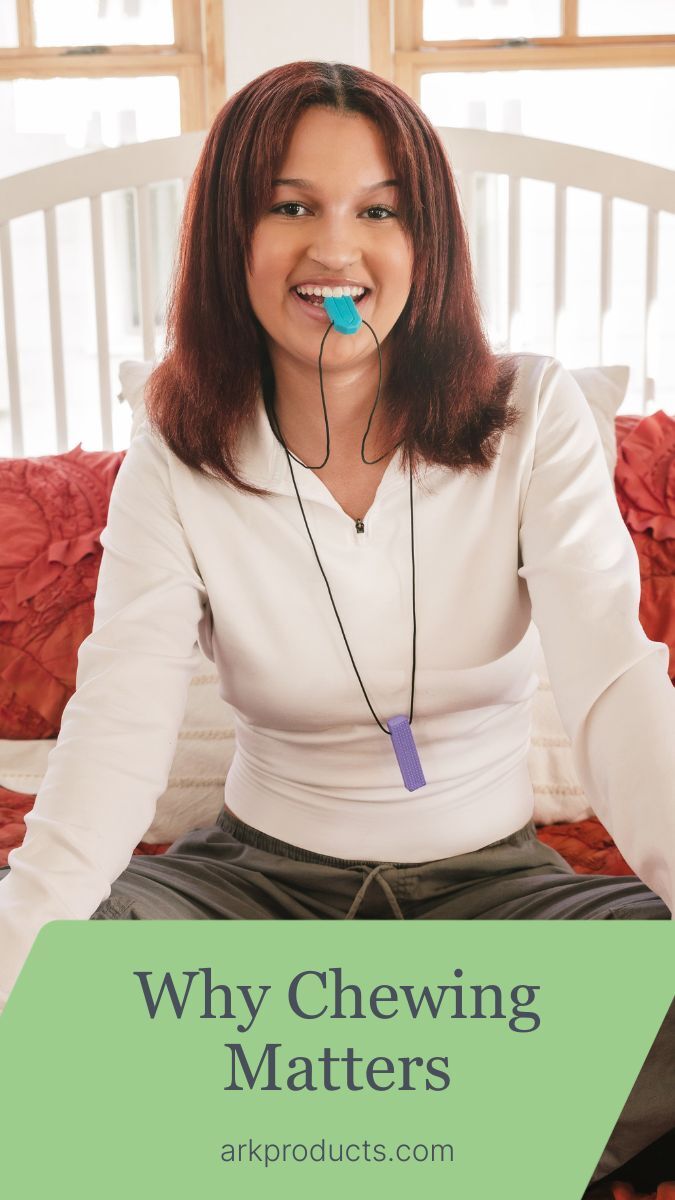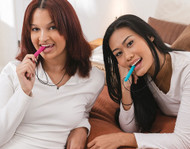Why Chewing Matters: How Chew Tools Support Sensory Needs
31st Jul 2025
Chew tools may seem simple at first glance, but they pack a long list of benefits. For many people, they’re a simple way to self-regulate, focus, and cope with everyday stress and anxiety. For others, they’re a tool to quit smoking or replace nail biting habits. For others yet, they’re a go-to therapy tool to build oral motor skills like jaw strength.
At ARK, we've designed over 100 different chew tools to support all of the above and everything in between. Whether you're looking for yourself, supporting a child with sensory needs, or researching tools as a therapist or teacher, this guide outlines what chew tools are, who they’re for, and how they can make everyday life a little easier.
.
What Are Chew Tools?
ARK chews (also sometimes called "chewelry", chewies, sensory chew toys, bite sticks, etc.) are specially designed chewable products that provide a safe outlet for chewing. They come in various shapes, textures, and resistance levels to meet different sensory preferences and chewing intensities. Some options are handheld, while others are more discreet and wearable for easier support on-the-go, like chewable necklaces, bracelets, and pencil toppers.
.
Who Can Benefit from Chew Tools?
Chew tools can be helpful for anyone who needs to chew for any reason, and for all ages from babies to kids to teens and adults. They can be especially helpful for individuals with:
- Stress or anxiety
- ADHD
- Autism Spectrum Disorder (ASD)
- Sensory Processing Disorder (SPD)
- Feeding or oral motor difficulties
- Sensory-seeking needs
.

Why Do Some People Chew?
Chewing is a normal part of early oral development. Some individuals continue to chew throughout their life for a variety of reasons. In our experience over the last 25+ years, chewing often serves at least one or a combination of the following purposes:
- A Safe Outlet for the Need to Chew: Chewing is a natural way for many people (especially those with sensory needs) to get the input their body craves. Without a safe outlet, that need doesn't go away. Instead, it often shows up in ways that could cause frustration or possibly even harm, whether that's directed internally or externally. For example, it could translate to chewing on one’s fingernails, hands, clothing, pencils, toys, etc. Chew tools instead redirect that energy into something that’s designed specifically for the need to chew that’s comfortable, durable, and safe.
- Supporting Self-Regulation: Chewing provides deep proprioceptive input to the jaw, which is a type of sensory input that’s calming and organizing to the nervous system. Think of how people may bite their nails, chew gum, or tap their fingers when they’re nervous. Chewing is a natural, instinctive way to self-soothe, especially in moments of stress or feeling overwhelmed. And especially for kids! Kids usually don't have access to the same healthy alternative coping mechanisms that we do as adults (meditation, exercise, hobbies, etc). School transitions and other stressors can be particularly tough for children, so having access to a chew tool is a simple way to help them manage big feelings.
- Increased Focus and Attention: Repetitive oral movement can be grounding, helping people concentrate and stay present in the moment. By channeling energy into a rhythmic activity like chewing, many people find it easier to focus and concentrate.
- Oral Motor Development: Chew tools can be used to support a variety of oral motor skills that support speech and feeding development, such as jaw strength, lip closure, tongue lateralization, and more. In particular, the Grabber and Y-Chew are oral motor staples commonly used by speech-language pathologists and occupational therapists in oral motor / feeding therapy. The long extensions make these chew tools very versatile for oral motor exercises.
- Addressing Oral Sensitivities: For individuals with oral defensiveness or texture aversions, gradually introducing different textures through chew tools (as well as with other tools like the Z-Vibe and/or textured spoons) can help desensitize the mouth and improve tolerance of different textures. The idea is to start with tools that provide gentle, mild input like the Y-Chew and gradually progress to more textured options like the Textured Grabber and Tetra-Bite.
Why Redirecting Is Better Than Stopping the Chewing
When someone is chewing on their shirt sleeves, collars, pencils, remote controls, arms, etc., it may be tempting to ask them to stop. But in many cases, they aren’t chewing out of defiance, but rather because their body needs it.
Whether they’re feeling overwhelmed, over-stimulated, under-stimulated, trying to focus, or just figuring out how to feel “just right” in their body, chewing is one of the few things kids in particular can control in the moment. So instead of trying to eliminate the behavior, we can redirect it to something that's healthier and more appropriate and effective, and validate a real sensory need in the process.
.
Best Times to Use a Chew Tool
Chewing tools may be a regular part of a sensory diet, or simply used as needed throughout the day. Some helpful moments may include:
- During homework or at work
- In the car or on public transportation
- During therapy sessions
- While waiting at appointments
- In response to transitions, stress, or overstimulation
- Any time sensory needs arise
Note: It’s important to remember that chewing can ebb and flow over time, especially in response to stress levels and other needs.
.
How to Choose the Best Chew Tool
Sensory needs are almost never “one size fits all”, which is why we have so many options! For example, ARK chews come in three different color-coded toughness levels:
- Standard / Soft – For light or occasional chewers (who never chew through anything)
- XT / Medium Firm – For moderate or frequent chewers (who may occasionally chew through things)
- XXT / Super Firm – For strong or aggressive chewing needs (who regularly chew through things, especially tough items)
Other features to consider:
- Longer tools that can reach the back molars for deeper jaw input
- Wearable options like necklaces or bracelets for on-the-go chewing
- Pen and pencil toppers that offer discreet support in the office or classroom
In short, embracing the need to chew can be very impactful in many different ways. When kids and adults have the right tools to feel calm, focused, and in control, everything else becomes just a little bit easier.
Need personalized recommendations? Check out our Chew Quiz or reach out to our customer team. All of our chew tools are made with care in Columbia, South Carolina from our family to yours, and we're here to help!
.

